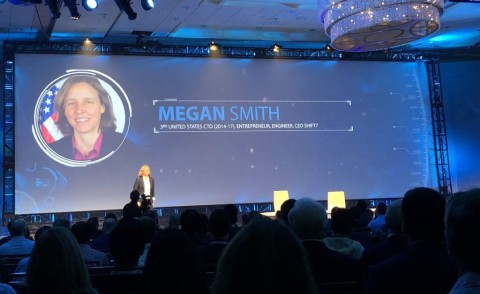Less than 15 percent of supply chain executives are female. Even fewer are women of color. That’s a sad state of affairs, and desperately needs to change. So how is it that with so many strong, courageous, talented women, so few have found a way to break through the glass ceiling? Kristen LeBaron, Director of Supply Chain at Lippert Components, Heather Mason, Inventory Program Manager at Applied Materials, Tonia Chu, Global Business Process Owner at Sanofi Genzyme and Pamela Passman, a member of the Kinaxis Board of Directors, shed some light during the Women in Supply Chain Breakfast on day two of Kinexions ’18, our annual user and training conference.
Raise your voice
As these four fearless female leaders opened up about the triumphs and tribulations in their careers in supply chain management, one piece of advice kept coming to the forefront. Speak up. “Learn to advocate and speak up for yourself,” advised Mason. “You can’t always count on someone else to do it for you.” “If recognition doesn’t come to you, you have to make it happen,” added Chu. “Speaking up is about more than just recognition. You have to be able to raise concerns, and actually have them heard.” But speaking up as a woman in a male dominated environment is rarely easy. When men do it, they’re seen as confident leaders. When women do it, they’re seen as, well, another word for female dogs. So how do we overcome it?
Amazing start to the morning with the Woman in Supply Chain breakfast. Great conversation and insights! #Kinexions #Kinexions18 pic.twitter.com/uVaJnnPjn3
— Kinaxis (@Kinaxis) October 17, 2018
Stand strong together
By coming together as women to raise each other up, instead of tearing each other down. “If it’s a small slight, I’ll let it go,” said Chu. “But if it’s something big, you have to bring it up and make sure everyone knows that kind of workplace harassment isn’t okay.” “I’ve found that the people making snide comments are unhappy in their own roles and feeling resentful that you’re working on something important,” notes LeBaron. “Help them find value and purpose. Include them. Excite them. That way they become engaged in what you’re doing instead of acting against it.” Women need to empower women through leadership, mentorship, guidance and support. As Passman put it, “Work on becoming a better leader. Leadership isn’t about how many people you supervise, or how big your budget is. It’s the ability to bring people – both men and women – along on a shared vision and journey. Help them understand their role, how critical they are to success and put the spotlight on all their hard work.” Standing strong together isn’t just about women supporting women, or even men supporting women. It’s about people supporting people, no matter their gender, age, race, religion, experience or passions.
Unite the collective genius
, CEO of shift7, former Chief Technology Office of the United States of America and day two keynote speaker at Kinexions, spoke about just that. For her, uniting the collective genius is about unlocking the power of all the people who might solve problems in new and interesting ways.
“What is we can open data sets to students in order to do good in their communities? To work on what they’re most passionate about?” - U.S. #CTO @smithmegan#Kinexions #opendata #education pic.twitter.com/bluQcoi3sR
— Dion Hinchcliffe (@dhinchcliffe) October 17, 2018
“The more diverse the team, the better, higher performance you’ll see,” explained Smith. “It may feel uncomfortable at first, but that friendly friction gets results. Just do it. Practice makes permanent. If you team up, then together you’ll be extraordinary.” Finding those diverse teammates can be a challenge in itself due to conscious and unconscious bias. “Just because you don’t know someone different from you who could fill that job opening doesn’t mean they don’t exist,” she cautioned. “Find someone who knows someone who knows someone and start from there.” Kinaxis CEO John Sicard, who joined Smith on stage for a Q&A session, shares Smith’s passion for diversity. “It’s always been our view at Kinaxis that the greatest innovations come from diversity of thought,” explained Sicard. “That’s why we created our Autism at Work program. We’re committed to having 1% of our workforce comprised of people under the autism spectrum. Not because we want to meet some quota, but because these individuals are incredibly talented and bring enormous value to what we do.” They’ll be challenges in overcoming deep-rooted bias and diversity issues. No doubt about it. And as Smith noted, the technology we’re creating is in some cases adding to the problem. Just look at recent examples like Microsoft’s Tay chat bot, Google’s image recognition algorithm or Amazon’s internal AI-based recruiting tool.
Get passionate about human intelligence
“Science and technology are really about passion and love,” explained Smith. “We need to get excited about human intelligence, not artificial intelligence. There’s too much focus on things like self-driving cars, and not enough on applying technology to solve complex problems. How can we use AI to solve gender inequality and discrimination issues? That’s where we should focus the use of technology.” We can use technology to do more than just make our lives better. We can use it to help make our world better. But we have to be open to those kinds of possibilities first. In my opinion that starts with changing the conversation around equality. It’s not enough to break down doors. We have to rip them off the hinges. Not just so women can come through. But so everyone can.
Additional Resources
- Supply chain management frequently asked questions





Discussions
Leave a Reply